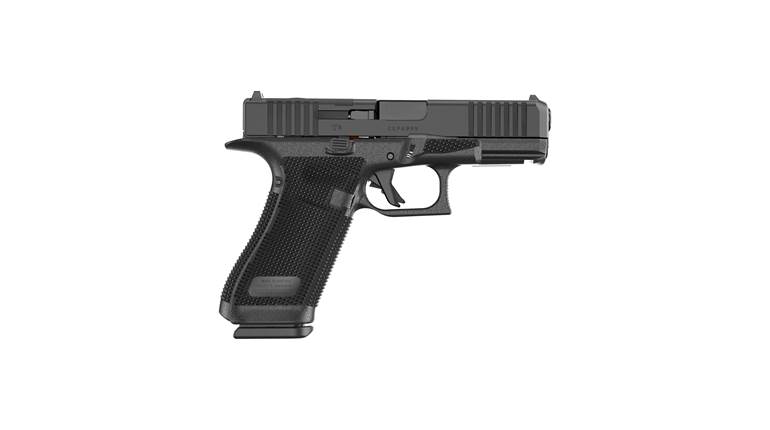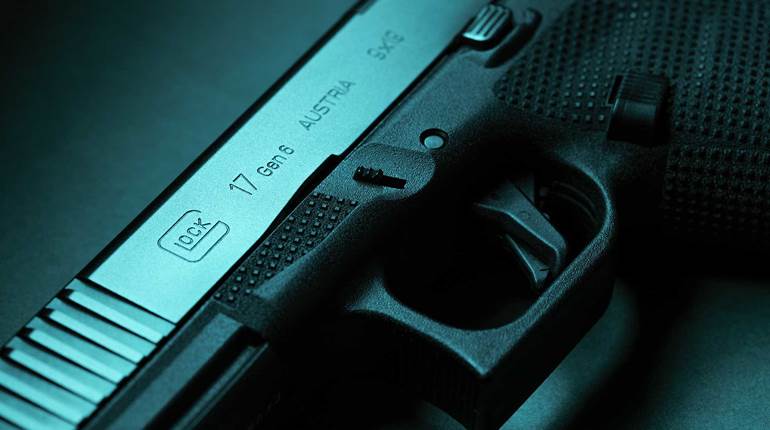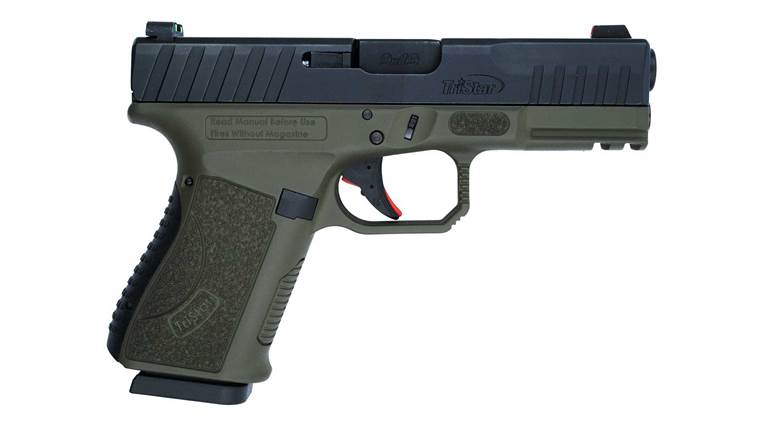
Lipsey’s is a distributor known for putting together limited runs of popular firearms that have special features. For the past few years, it has released a limited-run annual collaboration with Vickers Tactical and Glock that incorporates a unique set of features or color schemes. This year I had a chance to test one of the Lipsey’s/Vickers Glock 17s. This proved to be an interesting opportunity because I had just recently established a pretty good performance baseline with a box stock Glock 17 Gen 4 for another project. As I shot the Vickers gun over several months, I was able to directly assess the special run feature’s performance relative to the vanilla Glock 17. 
The Lipsey's special run Vickers Tactical Glock 17 was shot against a stock Glock 17 across a variety of drills.
People buy limited edition guns like this for a variety of reasons, all valid. The first is probably that the pistol is familiar, yet unique. Overlapping for some customers is that they identify positively with the figure/celebrity/organization that has spec’d out the changes. For some, the features themselves provide the incentive, allowing the customer to get something at the counter saving cost or effort from upgrading the base gun on the aftermarket at a later time.
Running down that list for the subject, Glock, is all check, check, check. This is a unique Glock, but still the model 17 that has been the ubiquitous commodity around the world for 35 plus years. Larry Vickers is one of the most prominent shooters/trainers/consultants in the industry with a strong presence on every media platform and relationship across the industry. When he specs out a gun with features that he endorses or that have his branded accessories, it is a powerful draw to the consumer. And the feature set on this 9 mm runs from one end to the other and from top to bottom.
Starting at the top, the Glock is wearing Wilson Combat/Vickers Tactical Battlesights. The rear features a serrated face surrounding a generous U notch. The front is a serrated steel ramp with a gold bead inset. The .080” bead works remarkably well to reflect light in a wide variety of conditions and is proportionally sized to float in the U notch. The sights alone will be a drastic improvement over the polymer factory sights for many shooters. The .125” front allows a healthy amount of light to push through the rear notch as the shooter aligns the pistol, but not so much as to hinder exact centering in precision shooting.
Moving down the slide the shooter will find a special “LAV” prefix on the serial number to show that the handgun is part of the Lipsey’s Vickers Tactical batch. The slide stop is a Vickers Tactical part also, a gently reshaped and extended shelf to assist in chambering a round. I have purchased this part and upgraded several Glocks with it, so I was immediately happy to find it on this model. The magazine release is another Vickers part, sensibly extended with radiused corners. Unlike some extended releases, this model facilitates access to the release without increasing the risk of inadvertent activation.
The sensibly extended slide stop and magazine release are visible as well as the unique RTF2 texture which anchors the hand exceptionally well.
The Glock design leaves a void at the bottom rear of the backstrap. Many shooters buy an accessory plug that fills this void and also serves as a mag guide if the magazine has drifted slightly rearward and offcourse during a reload. The Lipsey’s Glock incorporates the new Tango Down/Vickers tactical plug. This part has a unique profile that I found to give the base of my hand just a smidgen more bearing surface and the front was quite helpful in guiding magazines in during reloads. A “bonus” feature of the part is that the plug incorporates a stainless steel pin which serves as a disassembly tool to completely strip the pistol.
The package includes a combination grip plug that gently aids reloads and incorporates a takedown tool.
The final Vickers accessories on the package are replacement magazine baseplates. The Vickers part is noticeably wider than the stock unit. This may aid shooters in several ways. First, the additional lip may help in retrieving the magazine from a pouch, particularly a tightly fitted one or while the operator is wearing gloves. The additional surface area may help seat a fully filled magazine when the slide is forward, and the grooved area on either side can help strip the magazine if a hard stoppage occurs.
Perhaps not immediately noticeable until the Vickers Glock is grasped is what is likely the main feature for many: the RTF2 frame. The RTF2 was a rough texture frame introduced by Glock in 2009 that addressed complaints that the polymer was slippery in some conditions. The texture was a huge hit with a set of the shooting world given to rough hands, shooting with gloves, or a high demand for anchoring the gun to the max extent.
It was not, however, a commercial hit, and was dropped from the standard catalog and over time became a high-demand item on the secondhand market. At the time that Glock introduced the RTF2, I wasn’t paying attention and didn’t get my hands on one. My time and attention were focused intently on issued platforms, and my unit had not yet switched to Glocks. This was my first exposure to the cat-tongued frame and I immediately noticed the amount of traction. Once the shooter tightens up into a firing grip, the hundreds of tiny little points (polymids, in Glock parlance) really lock the pistol in place. In talking to shooters with more time on the frame, I learned that those who claimed the more abrasive frame texture had no ill effect against the body in concealed carry and those who claimed it was uncomfortable.
This pistol shot well for me from the start, and the more I shot it, the better I liked it. The frame texture and Vickers Tactical accessories worked together quite well as a team. In accuracy testing I fired old standby CCI Blazer, Hornady’s new Law Enforcement frangible load, and Black Hills +P jacketed hollowpoints. The overall average was 2.2”, on the very solid side of respectable from my hands.
The test gun is creeping up on 2,000 rounds downrange with no stoppages or anomalies to report. Ammunition used in addition to the grouped loads has been a mix of Winchester white box and the new steel cased USA Forged, Blazer, Black Hills FMJ, and handloads with Hornady HAP bullets.
In each range session, the Lipsey’s gun shot quite similarly to a couple of “pet” Glocks that have been upgraded in various ways and several horse lengths ahead of the box stock 17 that I recently tested. A couple of drills highlight the performance differences.
One of my staple drills is an accuracy oriented run of two strings at 25 yards two handed; five shots in 20 seconds followed by another five in 10 seconds. The possible score is 100 on the traditional B8 NRA competition bullseye. With the stock Glock, the average hovered around 90. The Vickers 17 was consistently 95 with a few down to 92 and a corresponding couple up at 97. This is about as good as I can average with even my competition Glock 34 with its aftermarket target sights and lighter trigger. The Battlesights were a big help here, allowing a crisp picture head and shoulders above the stock units. I also found the stickiness of the RTF2 texture to help anchor the gun against a clean press of the trigger. The Vickers 17 trigger is no better or worse than other stock Glocks but having the firing hand so firmly in place seems to assist getting clean pressure to the rear to release the striker.
At 10 yards I ran the plate rack; six 8” steel plates shot from the ready for time. With the stock Gen 4 gun, I had averaged 3.06 seconds for all six plates. With the Vickers gun, the gold bead seemed to just be where it needed to and the plates leapt from the rack as low as 2.37 and about 2.5 on average. A quarter second lead is a meaningful interval comparing times gun to gun on the plate rack, equating to a noticeable advantage on each plate. Over a half second as the interval here is quite a testament to the Lipsey’s package.
Many shooters place value on the traditional El Presidente drill, which begins with a draw from a 180-degree turn and then has the shooter fire pairs on three silhouettes, reload from slide lock, and fire three more pairs. This drill really played to the various strengths of the pistol. The texture locked the gun in solidly, the bright bead allowed me to paint through the targets with no wasted time on over-confirming alignment, and the Tango Down mag release, baseplates, and then slide release boosted reload speeds faster than my usual Glock times. My times were a personal best for a factory gun and a full 1.85 seconds ahead of the basic 17.
At 7 yards, I used the Hornady Frangible ammunition to shoot a max speed drill on a Defense Targets “Noner” reduced size steel chestplate with an attached 6” hostage taker “flipper” head plate. I like to shoot a pair from the ready to the chestplate and then immediately transition to the head flipper. With a stock 9 mm, I was trying to beat 1.25 seconds and can usually get a little below there with effort and repetitions. The Lipsey’s gun broke 1 second on two separate trips, a .99 and .96, which are my current personal bests.
The best 25-yard group was this impressive 1" spread shot with Hornady 90-gr. Frangible.
The final comparison was the 5 Yard Roundup drill. Shot against an 8” circle at 5 yards, there are four strings of 1.5 seconds each. The shooter puts as many hits in the circle as possible in that brief span from the ready, then from the holster, from strong hand only, and finally support hand only. My stock gun tallies tend to be about 11 to 12 total hits, as they were with the vanilla 17. My top end at the moment with modified pistols is 16 and the Lipsey’s special did just that as well. 
This is an outstanding package for those who like the Gen 3 frame and would otherwise be inclined to take a base gun and then add the parts and potentially send it out for custom stippling. The only addition I have made over time is to add a small sliver of 3M tread tape to the frame flat ahead of the takedown lever where my support hand thumb rests. I wish that Glock would have textured that area with some of those wonderfully effective polymids.
I would love to see Lipsey’s make this a regular catalog item, because it is a very good package for those considering a Glock 17.
Load Velocity SD
Black Hills 124-gr. +P JHP 1254 18
CCI 115-gr. Blazer FMJ 1168 14
Hornady LE 90-gr. Frangible 1425 13
10 shots at 10 feet; 52 degrees F
Load Best Worst Average
Black Hills 124-gr. +P JHP 1.80 2.23 2.06
CCI 115-gr. Blazer FMJ 1.65 2.82 2.22
Hornady LE 90-gr. Frangible 1.00 3.01 2.34
5 groups of five shots fired from a rest at 25 yards




































